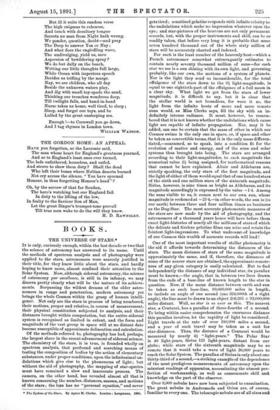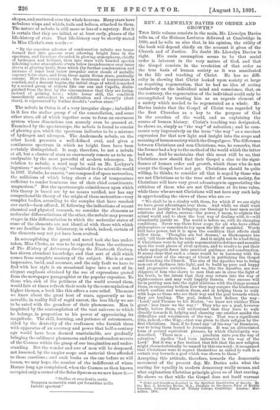BOOKS.
THE UNIVERSE OF STARS.* IT is only, curiously enough, within the last decade or two that the science of astronomy has answered to its name. Until the methods of spectrum analysis and of photography were applied to the stars, astronomers were scarcely justified in their title, for they knew little about the stars, and hardly hoping to know more, almost confined their attention to the Solar System. Now, although sidereal astronomy, the science of astronomy par excellence, is still in its infancy, we may discern pretty clearly what will be the nature of its achieve- ments. Surpassing the wildest dreams of the older astro- nomers in range and penetration, modern astronomy yet brings the whole Cosmos within the grasp of human intelli- gence. Not only are the stars in process of being numbered, their motions, proper and relative, in course of measurement, their physical constitution subjected to analysis, and their distances brought within computation, but the entire sidereal system is recognised as limited in exfent, and the form and magnitude of the vast group in space will at no distant date become susceptible of approximate delineation and calculation.
Of the methods referred to, photography has had, perhaps, the largest share in the recent advancement of sidereal science. The chemistry of the stars, it is true, is founded wholly on spectrum analysis, that profound and searching means of testing the composition of bodies by the action of elementary substances, under proper conditions, upon the infinitesimal un- dulations which give rise to the phenomena of light; but without the aid of photography, the mapping of star-spectra must have remained a slow and inaccurate process. The camera, on the other hand, has revealed almost all that is known concerning the number, distances, masses, and motions of the stars ; the lens has no "personal equation," and never
* The System of the Stays. Bi Agnes N. Olerke. London ; Longmsns. 1590.
gets tired; sensitised gelatine responds with infinite celerity to the undulations which make no impression whatever upon the eye; and star-pictures of the heavens are not only permanent records, but, with the proper instruments and skill, can be so readily taken, that before very long it is probable that some seven hundred thousand out of the whole sixty million of stars will be accurately charted and indexed.
For such is the least number of the heavenly host—which a French astronomer somewhat extravagantly estimates to. contain nearly seventy thousand million of suns—for each star we see is a sun shining with its own light, and governing probably, like our own, the motions of a system of planets. Nor is the light they send us inconsiderable, for the total effulgence of the stars down to the 9i light-magnitude, is equal to one eightieth-part of the effulgence of a full moon in a clear sky. What light we get from the stars of lower magnitude, it is difficult to say, but it is clear that the stellar world is not boundless, for were it so, the light from the infinite hosts of more and more remote suns would, as Miss Clerke says, fill the sky with an in- definitely intense radiance. It must, however, be remem- bered that it is not known whether the undulations which cause light are capable of infinite propagation. Nor, may it be added, can one be certain that the mass of ether in which our Cosmos swims is the only one in space, or, if space and ether be taken as convertible terms, that it is the only mass differen- tiated,—coarsened, so to speak, into a condition fit for the evolution of matter and energy, and of the suns and solar systems thus brought into being. The stars are arranged according to their light-magnitudes, to each magnitude the numerical value 2t being assigned, for mathematical reasons that cannot be here explained. Altair and Aldebaran are, strictly speaking, the only stars of the first magnitude, and the light of either of them would equal that of one hundred stars of the sixth and one million stars of the sixteenth magnitude. Sirius, however, is nine times as bright as Aldebaran, and its magnitude accordingly is expressed by the value –1.4. Among the suns visible to us, it comes next to our own sun, whose magnitude is reckoned at –25.4,—in other words, the sun is (to. our earth) between three and four million times as luminous as the Dog-Star. The most accurate photometric measures of the stars are now made by the aid of photography, and the astronomers of a thousand years hence will have before them exact light-histories of nearly all the millions of stars of which the delicate and tireless gelatine films can seize and retain the faintest light-impressions. To what undreamt-of knowledge of our Cosmos this wealth of accurate records will lead !
One of the most important results of stellar photometry is the aid it affords towards determining the distances of the stars. The mean distance of stars of the same magnitude is approximately the same, and if, therefore, the distances of some of the nearer stars are obtained, the approximate remote- ness of any given category is easily calculated. But to find independently the distance of any individual star, its parallax must be known,—the angle, that is, between two lines drawn from the ends of a base-line of known length to the star in question. Now, if the mean distance between earth and sun be taken as such base-line, 93,000,000 miles in length, to include an angle of one second (one 324,000th of a right angle), the line must be drawn to an object 206,265 x 93,000,000 miles distant. Well, no star is so near as this. The nearest star, a Centauri, has a parallax of three-fourths of a second. To bring within easier comprehension the enormous distance this parallax involves, let the rapidity of light be considered. Light travels at the rate of over 180,000 miles a. second, and a year of such travel may be taken as a unit for star-distances. Thus, the distance of a Centauri would be measured by nearly 4i "light-years." The Polar Star is 40 light-years, Sirius 121 light-years, distant from our globe; while stars of the sixteenth magnitude may be so remote that it would take a wave of light 36,000 years to. reach the Solar System. The parallax of Sirius is only about one thirty-third of a second,—a striking example of the dependence of the most prodigious measurements of astronomy upon the minutest readings of apparatus, necessitating the utmost per- fection of workmanship, as well as consummate skill and knowledge on the part of the observer.
Over 8,000 nebnhe have now been subjected to examination. The great nebula) in Andromeda and Orion are, of course, familiar to everyone. The telescopic nebulfe are of all sizes and shapes, and scattered over the whole heavens. Many stars have nebulous wisps and whirls, tails and helices, attached to them. The nature of nebula is still more or less of a mystery. But it is certain that they are initial, or at least early, phases of the life-history of stars. That life-history may be shortly stated
in Miss Clerke's own words :— " By the ceaseless advance of condensation nebuhe are trans- formed first into gaseous stars (showing bright lines in the spectrum, and therefore shrouded in glowing atmospheres, chiefly of hydrogen and helium), then into stars with banded spectra (showing outer atmospheric strata below incandescence over inner strata at glowing heat), from which (by further condensation and increase of inner heat below irregular outer clouds of metallic vapour) Solar stars, and from these again Sirian stars, gradually emerge. Here the ascent ends ; the maximum of temperature is reached, and a descent begins,the initial stage of which is marked by a second group of objects like our sun and Capella, distin- guished from the first by the circumstance that they are losing, instead of gaining heat ; while lower still, the condition immediately antecedent to solidification and obscurity (dark stars), is represented by Father Secchi's 'carbon stars."
The nebula in Orion is of a very irregular shape ; imbedded in it lies the stellar group of the constellation, and some other stars, all of which together seem to form an enormous system whose dimensions can scarcely even be guessed at. Examined by the spectroscope, the nebula is found to consist of glowing gas, which the spectrum indicates to be a mixture of hydrogen and nitrogen. The Andromeda nebula, on the other hand, presents a well-defined oval, and gives a continuous spectrum in which no bright lines have been certainly distinguished. It may, therefore, be not a nebula at all, but a cluster of stars so enormously remote as to be un- analysable by the most powerful of modern telescopes. In relation to nebula, a word may be said on Mr. Lockyer's ingenious "meteoric theory," submitted to the scientific world in 1887. Nebula, he asserts, "are composed of spare meteorites, the collisions of which bring about a rise of temperature sufficient to render luminous one of their chief constituents,
magnesium." But the spectroscopic coincidences upon which -this theory is based are by no means verified, nor has any comprehensible theory of the origin of these meteorites—very complex bodies, according to the samples that have reached
our earth—been offered. If, following the indications of recent chemical and physical research, we consider the elements as molecular differentiations of the ether, the nebula may present stages in this differentiation in which the molecular states of
some of the elements are not identi3a1 with those with which we are familiar in the laboratory, in which, indeed, certain of the elements may not yet have been evolved.
In accomplishing the great and novel task she has under- taken, Miss Clerke, as was to be expected from the authoress of The History of Astronomy during the Nineteenth Century, has shown abundant knowledge, and that sort of skill which comes from complete mastery of the subject. She is at once impressive, lucid, and accurate, and the only fault we have to find with her style is an occasional lapse into a sort of in- elegant emphasis obtained by the use of expressions quoted from the newspaper paragraphist or the popular expositor. To those who, sick of the pettiness of the world around them, would fain at times refresh their souls by the contemplation of higher themes, a book like this offers a sure relief. The more we know about the great host of stars, apparently so im- movable, in reality full of rapid unrest, the less likely we are to be sated with the grandeur of their phenomena. Man is inspirited by the contemplation of the vast universe to which he belongs, in proportion to his power of appreciating its magnitude. The skill, learning, and patience of astronomers,
aided by the dexterity of the craftsmen who furnish them with apparatus of an accuracy and power that half-a-century ago would have been deemed unattainable, are gradually bringing the sublimest phenomena and the profoundest secrets of the Cosmos within the grasp of our imagination and under- standing. But the wonder and awe of men will be deepened, not lessened, by the ampler scope and material thus afforded to those emotions ; • and such books as the one before us will lessen, we may hope, the number of the indifferent of whom Horace long ago complained, when the Cosmos as then known occupied only a corner of the Solar System as we now know it :— " Stellas et recedentia certis
Tempera momentis aunt qui formidine nulla Imbuti spectent."



































 Previous page
Previous page